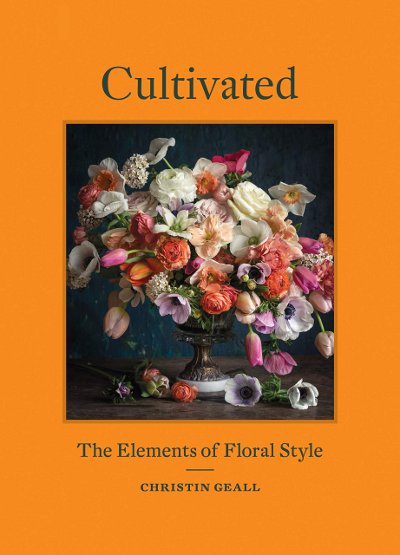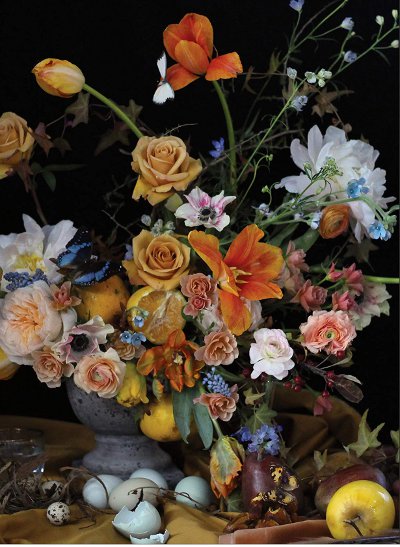
Cultivated, The Elements of Floral Style by Christin Geall
.
If you have any comments, observations, or questions about what you read here, remember you can always Contact Me
All content included on this site such as text, graphics and images is protected by U.S and international copyright law.
The compilation of all content on this site is the exclusive property of the site copyright holder.
Cultivated, The Elements of Floral Style
by Christin Geall, a book review
Wednesday, 30 September 2020
Once upon a time early March meant a day trip to the Philadelphia flower show with some friends. Flower arrangements were an amazing category occupying a significant portion of the convention center. There would be a class for small ones that could fit in a hand, others in the spare style of ikebana, or lush displays that overflowed their containers. Each and all, they showcased the color and beauty of flower, leaf, and branch.
Like everything else, flower arrangements do not emerge from thin air, out of a hidden door, by magic. There are principles of design and style. Fortunately these are not things that must be invented, arduously discovered. Knowledgeable and generous teachers share their understanding to start the novice down the path.

Cultivated, The Elements of Floral Style by Christin Geall
offers chapter and verse, beginning with flowers and plants necessary equipment and supplies, thinking of color, then segues through putting an arrangement together, learning from the past, and developing your work. And concludes with some basics about photographing your work and a bibliography of other books to read and learn from.
Wow. Sounds overwhelming. How could a novice learn to transform a bunch of flowers and greenery into a sensual, beautiful arrangement. Start at the beginning, then continue until the end. For one thing, the book is so beautifully illustrated that it could be in your library just to enjoy the pictures.

Image credit and copyright Christin Geall
When possible, grow your own, Geall advises. It brings you into an appreciation of the spirit of place, the importance of maintaining healthy soil, the ecology of the local environment. And once you've grown your own flowers - perhaps from seed, maybe planted bulbs for spring or summer bloom, whatever - once you cut the flowers here are tips for how to keep them fresh. For a while. Unless you dry them. Move beyond home-grown flowers to foraging in hedgerow, fields, empty lots, supermarkets . . . kale has wonderful foliage.
But flowers don't just float in space. To arrange flowers and foliage you will need containers of different shapes and sizes and materials. Then too, the mechanics to support the flowers: never ever floral foam made from petroleum. Chicken wire, twigs, bamboo skewers, all sorts of uses for elastic bands, floral tape, use a turntable and a mirror for a complete perspective. An arrangement is more than stuffing flowers into a jar and hoping it won't fall over.
 .
.
Images credit and copyright Christin Geall
Understanding of color, how we perceive it, how different colors make us feel.
A monochromatic color palette compared to analogous, related colors and then

Image credit and copyright Christin Geall
contrast. A little is good, too much is overwhelming. Throughout the book Geall's
photographs illustrate what the adjacent page of text describes and discusses.
 .
.
Images credit and copyright Christin Geall
Ten things to learn from ikebana are enumerated on the page facing the above left-hand image.
Green is a color, and Geall suggests foliage options beyond the familiar few, green flowers too.
I appreciate that for the majority of images the Latin and cultivar plant names are provided.
Learning from the past takes the reader and studious floral design student traveling through time and around the globe. Baroque style - luxury, opulence, beauty, order. Plants from around the world newly introduced as Dutch, English, Spanish, Portuguese traders sailed across the oceans.

Image credit and copyright Christin Geall
As with the ten concepts for ikebana, so too concepts
of the baroque period and for the Dutch floral still life.

Image credit and copyright Christin Geall
These precepts are concepts, not prescriptions. "Beauty is transient. Honor change and decay." Dutch paintings of the period often featured a skull, a snail-chewed leaf. Japanese wabi sabi, honoring the patina of time is a different take on this concept and yes, Geall discusses this also.
While philosophy is front and center, it balances on a practical foundation. Consider, Geall asks, how many of one plant should be blended with another, and how tall should an arrangement be. Not your high school algebra but a segue into the divine proportion and phi, the golden ratio described by Leonard of Pisa, perhaps better known as Fibonacci. Geall artfully suggests how these concepts may be applied to centerpieces that will require focal flowers, gestural flowers, filler flowers, foliage. So many of this, so many of that.

Image credit and copyright Christin Geall
Cultivated: The Elements of Floral Style is a book with many themes. It offers useful information on arranging plants and flowers. The lush images make it a pleasure to page through, enjoying the colors, arrangements, and botancal diversity. The concepts and philosophy of integrating this particular aspect of utilizing plants, considerations of ecology and the natural world, and incorporating tidbits from the history of civilizations - there is an impressive reading list at the back of the book - suggests a wider audience than the title might predict.
Cultivated, The Elements of Floral Style
by Christin Geall
published by Princeton Architectural Press, Hudson, New York
Hard cover, color images throughout, $27.50, 2020
ISBN 978-1-61689-820-5

Image credit and copyright Christin Geall
A review copy of this book was provided by the publisher
Back to Top
Back to September
Back to the main Diary Page